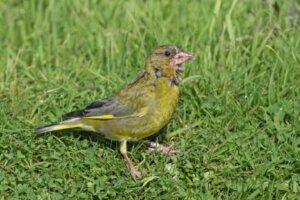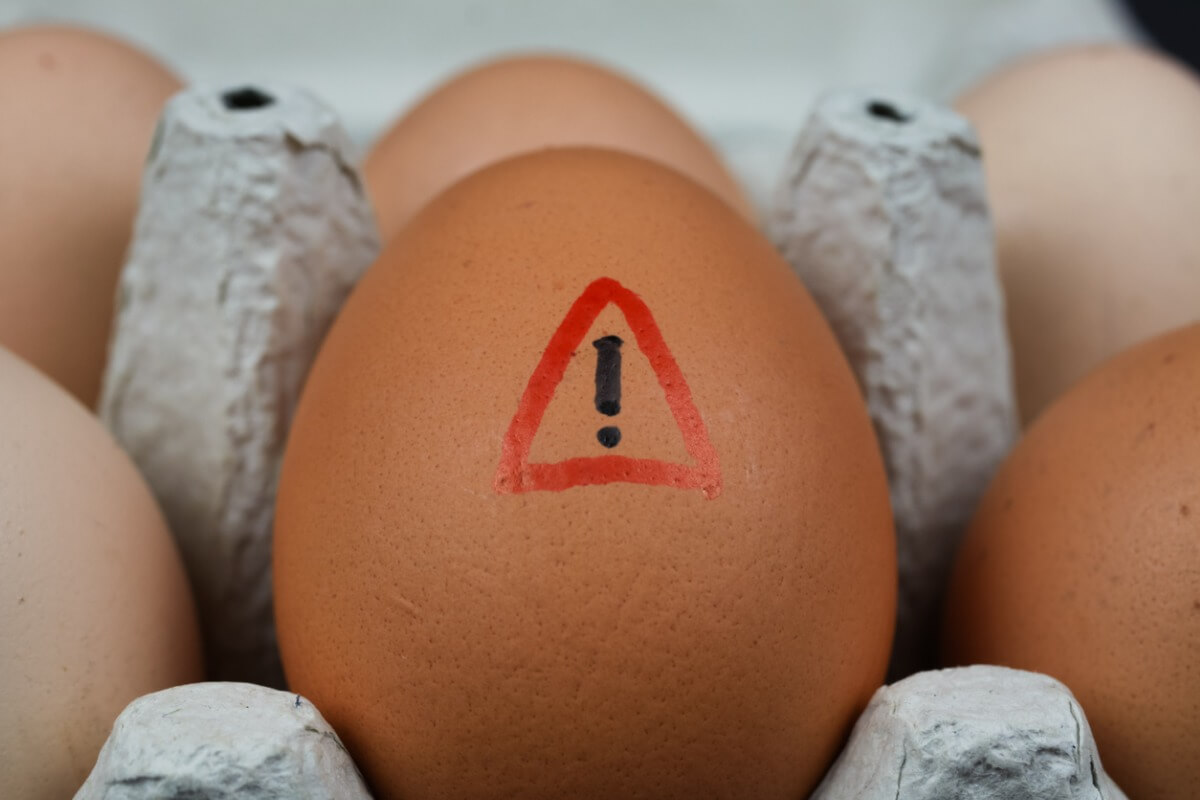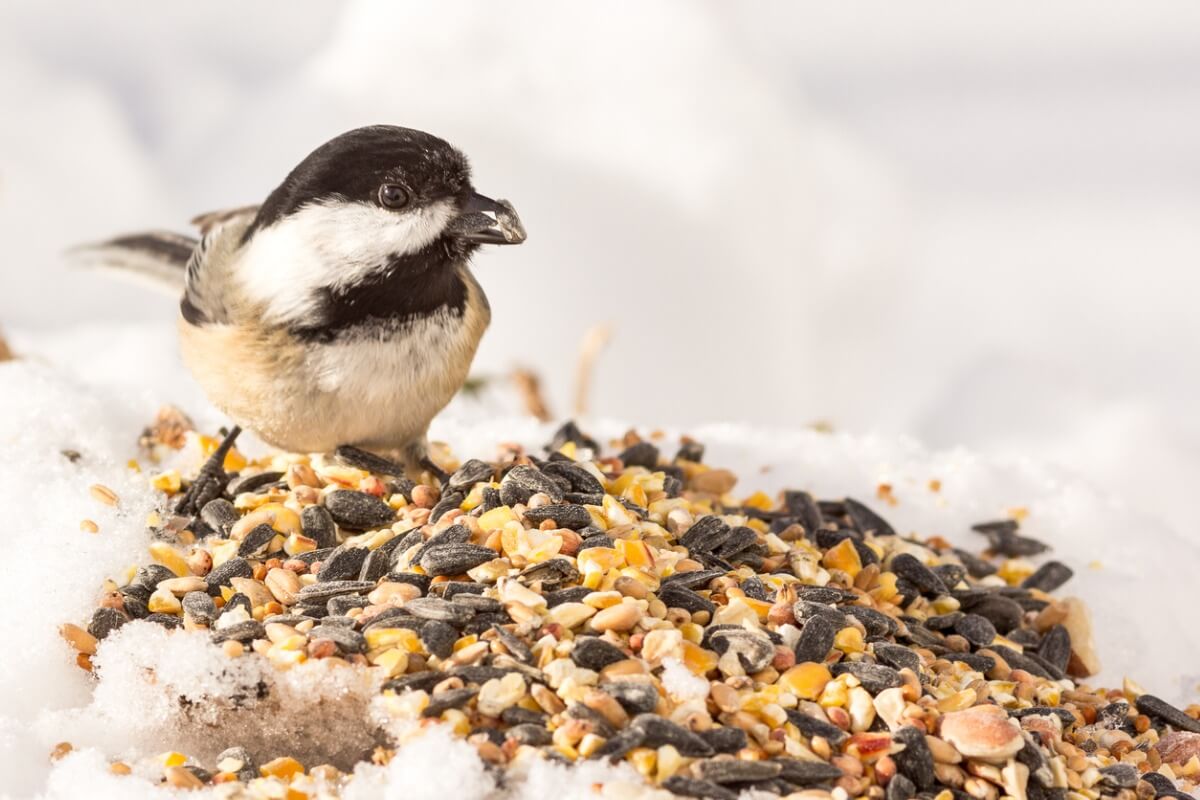Salmonellosis in Poultry: Causes, Symptoms and Treatment


Written and verified by the biologist Samuel Sanchez
Surely the term Salmonella sounds familiar to you, especially if you’ve suffered a gastrointestinal infection caused by eating eggs or other animal products at some point in your life. Although salmonellosis is a condition famous for affecting humans, it’s worth noting that birds and many other mammals can also suffer from it. Find out all about salmonellosis in poultry in this article.
Bacterial infections are relatively common in poultry, especially those kept in intensive production farms, crammed into small spaces. Keep reading, because in the following lines we’ll tell you what this condition is, how it manifests itself symptomatically and what its treatment is. Don’t miss it!
What’s avian salmonellosis?
The term salmonellosis refers to any bacterial infection caused by the Salmonella spp. complex, regardless of the species affected and the intensity of the medical condition. In poultry, the microorganisms that are usually considered as causal suspects are Salmonella gallinarum and Salmonella pullorum.
All poultry species are susceptible to Salmonella infection. However, professional sources indicate that the prevalence of the condition is higher in winter, especially in gregarious species that feed on seeds (Passeriformes). The vulnerability of each bird will depend on its general health, its immune strength, and the potency of the causative serotype.
Salmonellosis is a zoonotic disease, which means that it can be transmitted from birds to humans without much difficulty. It’s most often spread by ingestion of contaminated meat, eggs, or water, but direct handling of sick or dead birds is also an important route of entry of pathogens into the body.
The genus Salmonella includes more than 2500 serotypes and 6 subspecies. The ones that most affect birds are 1 and 3.

Causes
Salmonellosis in poultry is caused by several bacteria of the genus Salmonella. Understanding its etiology is simple, but the most important thing is to be clear about the routes of transmission. These are listed below:
- Infestation of small mammals: Rodents, for example, can become sick and release the bacteria with their feces. If a sick mouse defecates in the birds’ water source, it can infect an entire population.
- Vertical transmission: An infected female can transmit the pathogen to eggs before they hatch. The chicks will hatch sick and thus have infectious potential.
- Accumulation of garbage: As indicated by professional sources, flies are transmitters of the disease. The accumulation of waste will attract these and other invertebrate vectors of bacteria, which will greatly favor domestic birds getting infected.
- Accumulation of birds: Bacteria can be inhaled by breathing in microparticles which can survive well outside their host for a limited time. The more birds in a confined space, the more likely the disease is to spread.
- Stress: Stress depresses the birds’ immune system, which makes it easier for infections to occur.
The causation of salmonellosis in poultry is associated in almost all cases with poor animal care. Overcrowding, not feeding them what they should, keeping the facilities dirty, or exposing them to extreme stress are clear predisposing factors in the spread of this condition.
Symptoms
The infection usually manifests itself at a pharyngeal and gastric level, but it isn’t uncommon for the bacteria to colonize the liver and spleen. For this reason, the medical signs are usually general and shared with many other conditions. These are the most striking symptoms of salmonellosis in poultry:
- Yellowish-green diarrhea that stains the feathers in the cloacal region.
- General apathy.
- Lack of appetite and weight loss.
- Excessive and constant thirst due to water loss from diarrhea.
- Ruffled plumage.
It should be noted that this infection is considered to be very serious. The untreated mortality rate in adult birds is around 50%, but in nestlings the fatality rate rises to 95%. The most fragile birds will die within 1 to 3 days after showing the first symptoms.
Diagnosis of avian salmonellosis
The symptoms of avian salmonellosis are very similar to those that occur in other conditions, so the simple manifestation of clinical signs isn’t very helpful in making the diagnosis. However, suspicion will begin as soon as the caregiver emphasizes the diarrhea and dehydration present in the sick bird.
The diagnosis is quite simple, as all experts will need to do is analyze a stool sample in the laboratory (a stool culture) and isolate the causative bacteria. In any case, it’s likely that antibiotic treatment should begin before the arrival of the results, because if you wait too long the bird will eventually die.
Treatment
Veterinary portals indicate that the most popular treatment in almost all cases is the antibiotic enrofloxacin (commercial product Seriflox), at a rate of 10 drops per 40 milliliters of water present in the drinking fountain of the facility. This drug is also used to treat other concomitant infections. The total duration should be 19 days: 7 days of antibiotics, 5 days of rest and another 7 days of antibiotics.
Another alternative is the administration of chloramphenicol directly into the beak, especially if the bird is domestic and lives alone. Framycetin, sulfaquinoxaline, and B vitamins can be applied under veterinary care if other approaches don’t work.
It’s necessary to provide plenty of water to sick birds, as they tend to dehydrate when they have diarrhea.

Salmonellosis in poultry is a relatively common condition, especially in poultry production infrastructures with chickens. However, the best treatment is always prevention. Keep the birds’ facilities clean, take them for routine veterinary check-ups, and seek professional help as soon as you detect the slightest symptoms in them.
Surely the term Salmonella sounds familiar to you, especially if you’ve suffered a gastrointestinal infection caused by eating eggs or other animal products at some point in your life. Although salmonellosis is a condition famous for affecting humans, it’s worth noting that birds and many other mammals can also suffer from it. Find out all about salmonellosis in poultry in this article.
Bacterial infections are relatively common in poultry, especially those kept in intensive production farms, crammed into small spaces. Keep reading, because in the following lines we’ll tell you what this condition is, how it manifests itself symptomatically and what its treatment is. Don’t miss it!
What’s avian salmonellosis?
The term salmonellosis refers to any bacterial infection caused by the Salmonella spp. complex, regardless of the species affected and the intensity of the medical condition. In poultry, the microorganisms that are usually considered as causal suspects are Salmonella gallinarum and Salmonella pullorum.
All poultry species are susceptible to Salmonella infection. However, professional sources indicate that the prevalence of the condition is higher in winter, especially in gregarious species that feed on seeds (Passeriformes). The vulnerability of each bird will depend on its general health, its immune strength, and the potency of the causative serotype.
Salmonellosis is a zoonotic disease, which means that it can be transmitted from birds to humans without much difficulty. It’s most often spread by ingestion of contaminated meat, eggs, or water, but direct handling of sick or dead birds is also an important route of entry of pathogens into the body.
The genus Salmonella includes more than 2500 serotypes and 6 subspecies. The ones that most affect birds are 1 and 3.

Causes
Salmonellosis in poultry is caused by several bacteria of the genus Salmonella. Understanding its etiology is simple, but the most important thing is to be clear about the routes of transmission. These are listed below:
- Infestation of small mammals: Rodents, for example, can become sick and release the bacteria with their feces. If a sick mouse defecates in the birds’ water source, it can infect an entire population.
- Vertical transmission: An infected female can transmit the pathogen to eggs before they hatch. The chicks will hatch sick and thus have infectious potential.
- Accumulation of garbage: As indicated by professional sources, flies are transmitters of the disease. The accumulation of waste will attract these and other invertebrate vectors of bacteria, which will greatly favor domestic birds getting infected.
- Accumulation of birds: Bacteria can be inhaled by breathing in microparticles which can survive well outside their host for a limited time. The more birds in a confined space, the more likely the disease is to spread.
- Stress: Stress depresses the birds’ immune system, which makes it easier for infections to occur.
The causation of salmonellosis in poultry is associated in almost all cases with poor animal care. Overcrowding, not feeding them what they should, keeping the facilities dirty, or exposing them to extreme stress are clear predisposing factors in the spread of this condition.
Symptoms
The infection usually manifests itself at a pharyngeal and gastric level, but it isn’t uncommon for the bacteria to colonize the liver and spleen. For this reason, the medical signs are usually general and shared with many other conditions. These are the most striking symptoms of salmonellosis in poultry:
- Yellowish-green diarrhea that stains the feathers in the cloacal region.
- General apathy.
- Lack of appetite and weight loss.
- Excessive and constant thirst due to water loss from diarrhea.
- Ruffled plumage.
It should be noted that this infection is considered to be very serious. The untreated mortality rate in adult birds is around 50%, but in nestlings the fatality rate rises to 95%. The most fragile birds will die within 1 to 3 days after showing the first symptoms.
Diagnosis of avian salmonellosis
The symptoms of avian salmonellosis are very similar to those that occur in other conditions, so the simple manifestation of clinical signs isn’t very helpful in making the diagnosis. However, suspicion will begin as soon as the caregiver emphasizes the diarrhea and dehydration present in the sick bird.
The diagnosis is quite simple, as all experts will need to do is analyze a stool sample in the laboratory (a stool culture) and isolate the causative bacteria. In any case, it’s likely that antibiotic treatment should begin before the arrival of the results, because if you wait too long the bird will eventually die.
Treatment
Veterinary portals indicate that the most popular treatment in almost all cases is the antibiotic enrofloxacin (commercial product Seriflox), at a rate of 10 drops per 40 milliliters of water present in the drinking fountain of the facility. This drug is also used to treat other concomitant infections. The total duration should be 19 days: 7 days of antibiotics, 5 days of rest and another 7 days of antibiotics.
Another alternative is the administration of chloramphenicol directly into the beak, especially if the bird is domestic and lives alone. Framycetin, sulfaquinoxaline, and B vitamins can be applied under veterinary care if other approaches don’t work.
It’s necessary to provide plenty of water to sick birds, as they tend to dehydrate when they have diarrhea.

Salmonellosis in poultry is a relatively common condition, especially in poultry production infrastructures with chickens. However, the best treatment is always prevention. Keep the birds’ facilities clean, take them for routine veterinary check-ups, and seek professional help as soon as you detect the slightest symptoms in them.
All cited sources were thoroughly reviewed by our team to ensure their quality, reliability, currency, and validity. The bibliography of this article was considered reliable and of academic or scientific accuracy.
- Salmonelosis, BTO. Recogido a 25 de octubre en https://www.bto.org/our-science/projects/gbw/gardens-wildlife/garden-birds/disease/salmonellosis
- Flies and salmonella: a bad combo in poultry houses. Recogido a 25 de octubre en https://www.sciencedaily.com/releases/2008/03/080321124759.htm
- Salmonelosis, Aviario LHMAN. Recogido a 25 de octubre en http://www.aviariolhman.com/enfermedades_bacterianas_salmonelosis.htm
- Salmonella in birds, wagwalking. Recogido a 25 de octubre en https://wagwalking.com/bird/condition/salmonella
This text is provided for informational purposes only and does not replace consultation with a professional. If in doubt, consult your specialist.








